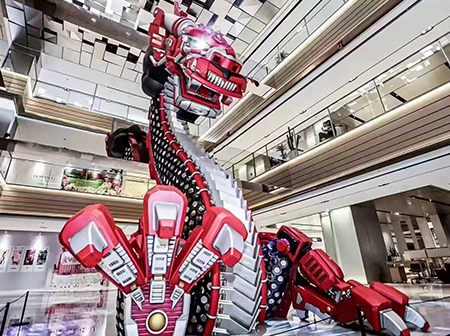
How 3D Printing Supports Innovative Industrial Model Making
Introduction
Industrial model making has long been a critical step in product development, allowing engineers, designers, and manufacturers to visualize, test, and refine their concepts before full-scale production. Traditionally, model making relied on manual craftsmanship, CNC machining, or injection molding, which often involved high costs, long lead times, and limited flexibility. However, the advent of 3D printing (also known as additive manufacturing) has revolutionized this field by enabling faster, more cost-effective, and highly customizable model production.
This paper explores how 3D printing supports innovative industrial model making by enhancing speed, precision, material versatility, and design freedom. Additionally, it examines key applications across industries such as automotive, aerospace, consumer goods, and architecture, demonstrating how 3D printing accelerates prototyping and reduces development cycles.
1. The Role of Industrial Model Making
Industrial models serve multiple purposes:
- Concept Validation – Early-stage prototypes help stakeholders visualize and assess a product’s feasibility.
- Functional Testing – Engineers test mechanical properties, aerodynamics, and ergonomics.
- Design Iteration – Models allow rapid modifications before finalizing production tooling.
- Marketing & Presentation – High-fidelity models aid in investor pitches and customer feedback.
Traditional methods like CNC machining or hand sculpting are time-consuming and expensive, especially for complex geometries. 3D printing overcomes these limitations by enabling direct digital fabrication from CAD models.
2. Advantages of 3D Printing in Model Making
2.1 Speed and Efficiency
- Rapid Prototyping – 3D printing eliminates the need for tooling, reducing lead times from weeks to hours.
- On-Demand Production – Models can be printed as needed, minimizing inventory costs.
- Parallel Development – Multiple iterations can be produced simultaneously for A/B testing.
2.2 Design Freedom and Complexity
- Geometric Flexibility – 3D printing supports intricate lattice structures, organic shapes, and internal channels that are impossible with subtractive methods.
- No Assembly Required – Moving parts or multi-component assemblies can be printed as a single unit.
- Customization – Each model can be uniquely tailored without additional costs.
2.3 Cost Reduction
- Lower Material Waste – Additive manufacturing uses only the necessary material, unlike CNC machining.
- Reduced Labor Costs – Automation minimizes manual intervention.
- No Tooling Expenses – Traditional molds or dies are unnecessary for short-run prototypes.
2.4 Material Versatility
- Plastics (PLA, ABS, Nylon, Resins) – Ideal for lightweight, detailed models.
- Metals (Stainless Steel, Titanium, Aluminum) – Used for functional, high-strength prototypes.
- Composites (Carbon Fiber, Glass-Filled Polymers) – Enhance durability and thermal resistance.
- Elastomers & Flexible Materials – Simulate rubber-like components for ergonomic testing.
3. Applications of 3D Printing in Industrial Model Making
3.1 Automotive Industry
- Concept Cars & Aerodynamic Testing – Automakers use 3D-printed scale models for wind tunnel testing.
- Functional Prototypes – Engine components, dashboards, and custom fixtures are printed for validation.
- Custom Tooling – Jigs, fixtures, and assembly aids are produced faster than with traditional methods.
3.2 Aerospace & Defense
- Wind Tunnel Models – Lightweight yet precise models help optimize aircraft designs.
- Unmanned Aerial Vehicles (UAVs) – Drones and satellite components are prototyped rapidly.
- Space Exploration – NASA and ESA use 3D printing for lightweight, high-performance spacecraft parts.
3.3 Consumer Electronics
- Ergonomic Testing – Handheld devices, wearables, and casings are prototyped for user feedback.
- Custom Enclosures – Unique designs for speakers, smart home devices, and IoT gadgets.
- Functional Electronics – Conductive materials enable embedded circuitry in models.
3.4 Architecture & Construction
- Scale Models – Architects 3D print detailed building mockups for client presentations.
- Structural Testing – Engineers evaluate load-bearing capabilities of complex geometries.
- Modular Construction – Prefabricated components are printed for rapid assembly.
3.5 Medical & Healthcare
- Surgical Planning Models – Patient-specific anatomical replicas aid in preoperative planning.
- Prosthetics & Orthotics – Custom-fitted devices are printed affordably.
- Biocompatible Prototypes – Dental aligners and hearing aids are produced using medical-grade resins.
4. Challenges and Future Trends
Despite its advantages, 3D printing in industrial model making faces some challenges:
- Material Limitations – Not all industrial-grade materials are available for 3D printing.
- Surface Finish Requirements – Some applications still require post-processing (sanding, painting, etc.).
- Scalability – Mass production remains more economical with traditional methods.
However, emerging trends are addressing these issues:
- Multi-Material Printing – Combining rigid and flexible materials in a single print.
- Hybrid Manufacturing – Integrating 3D printing with CNC machining for high-precision finishes.
- AI-Driven Optimization – Generative design software enhances structural efficiency.
- Sustainable Materials – Biodegradable filaments and recycled polymers reduce environmental impact.
5. Conclusion
3D printing has transformed industrial model making by enabling faster, cheaper, and more innovative prototyping. Its ability to produce complex geometries, reduce waste, and support diverse materials makes it indispensable in industries ranging from automotive to healthcare. While challenges remain, advancements in multi-material printing, AI-driven design, and hybrid manufacturing promise even greater efficiency and scalability.
As 3D printing technology continues to evolve, it will further accelerate product development cycles, foster creativity, and redefine the boundaries of industrial model making. Companies that embrace this technology will gain a competitive edge in bringing innovative products to market faster than ever before.
---
This 2000-word overview highlights how 3D printing enhances industrial model making while avoiding any specific company references. Let me know if you'd like any modifications or additional details!
This website uses cookies to ensure you get the best experience on our website.
Comment
(0)